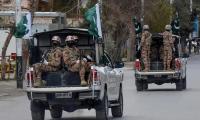Foreign trade is an excellent barometer to analyse the economic development of any country. The same is the case for Pakistan. At the time of Independence, the territory which came under Pakistan was mostly used for agricultural purposes. As a result, Pakistan’s economy was primarily of an agrarian nature, with a limited industrial component.
Pakistan was primarily relying on imports for manufactured goods. The country’s early leadership focused on industrialisation to reduce poverty levels and achieve economic growth. The contribution to the GDP from agriculture reduced from 48 percent to 22 percent between 1960 and 2011. The contribution to the GDP from industrial sector increased from 14 percent to 26 percent during the same period.
The average growth rate has been maintained around five percent since the country’s inception. During the first two decades, trading activities were primarily confined to import. Later, in the 1960s, Pakistan pursued a policy of import substitution whereby imported goods were substituted with locally produced goods. Later, in the 1970s, Pakistan pursued an export promotion strategy to boost trading activities. However, the balance of trade remained unfavourable for Pakistan.
Pakistan suffered major economic shocks during 1965 and 1971 because of the war with India. This forced Pakistan to rely on external loans and grants, creating a burden of foreign debt. There was a tendency to take more loans to pay for installments and interests of earlier loans. Government intervention – in the form of quotas, tariffs and exchange rates – to boost local production and impose better control on foreign exchange has resulted in an undocumented economy. According to a World Bank report, Pakistan’s parallel economy is 56 percent of the GDP. As per the FBR chairman, it accounts for 79 percent. This undocumented economy does not contribute to government revenue. If brought under tax net, it can generate an additional revenue of Rs1.97 trillion and curtail the need to borrow foreign exchange.
The composition of imports and exports has been varying because of the changes in the world’s economic situation. A sharp increase has been witnessed in trade with European countries. However, the share of overall trade has been declining. On the other hand, a sharp increase in trade is witnessed with Asian countries – both in terms of the value of trade and the overall share. With China rising as an economic power in Asia, it contributed towards most of the imports to Pakistan from the 1990s onward. 9/11 also resulted in a shift within the Pakistan economy. Foreign remittances were flowing to Pakistan from Pakistanis living abroad apart from foreign aid and grants.
Pakistan was primarily importing manufactured goods and exporting raw material in the early years. This changed significantly with industrial growth. The primary imports of manufactured goods – which were around 20 percent in the early 1950s – reduced during the last two decades. The main items that contributed to the reduction were textile goods, manufactured metals, machinery and transport equipment. Pakistan has been dependent on petroleum and petroleum products from the outset. With the growing industrialisation base, this has also come under pressure and the share of petroleum and petroleum products has increased from five percent to about 25 percent of the overall import bill.
The diversification of industrial production has resulted in the radical transformation of Pakistan’s export. The export of crude materials and commodities, which used to be about 90 percent in the past, has been reduced significantly to four percent during the last two decades. Raw cotton has been replaced by the textile yarn, cotton products and other textile products. Similarly, hides and skins were replaced with leather and leather products.
There have been positive developments as well. Pakistan has been awarded the status of the GSP Plus from the EU. This allows EU countries to import certain goods from Pakistan at a zero tariff since January 2014. Before the award, these countries were paying about six to seven percent import duty on goods exported from Pakistan. This offers a great opportunity for Pakistan to increase its exports to EU countries and establish its presence. The GSP Plus status requires the beneficiary countries to ratify and implement 27 international conventions pertaining to social compliance for human rights, labour rights, environmental protection and good governance. In order to ensure that its GSP Plus status persists, Pakistan needs to ensure compliance.
In order to have sustainable economic growth and adequate foreign exchange, Pakistan needs to eradicate the trade deficit and ensure that the balance of trade becomes favourable for Pakistan. This requires a series of initiatives to be taken.
First, the alignment of the production structure will need to be prioritised. Currently, Pakistan primarily exports in the areas of cotton and cotton products. Although there has been a change in trend and more manufactured goods are being exported as compared to raw materials, Pakistan needs to diversify its export base which requires diversification of production structure. The industrial policy should encourage the establishment of heavy, basic and engineering industries.
Second, self reliance should be emphasised. Loans and credits have also been worsening the economic situation of the country. The aid-giving developed world is also emphasising on recipient countries to rely on their own resources. The solution lies in self reliance and a focus on improving education, healthcare and the overall socio-economic infrastructure.
Third, the country has been blessed with an abundance of mineral resources – which include oil, gas, copper, coal and, to a certain extent, gold. This requires the exploration of mines through advanced techniques.
Fourth, one of the main sources of foreign exchange reserves are the remittances from Pakistanis living and working abroad. Measures should be taken by State Bank to offer incentives to use legal channels to bring back the money.
Fifth, private-public partnership is one of the preferred options to enhance economic activities. The bureaucratic management model has its own strength. However, this can be supplemented by the corporate culture and business acumen of the private sector. It has been an accepted fact that the private sector is able to introduce efficiency, skill, innovation, technology, finance and, most importantly, project risks from where the public sector can take a leap forward. On the other hand, the private sector can rely on state resources and expertise in fast-tracking approvals and implementation time-frames.
Sixth, the orientation of policymaking and industry should be focused on exports. For this purpose, Pakistan should introduce technology and management to increase the quality and quantity of its manufactured products and government measures to support the same. Measures should be introduced to protect manufacturing so that nothing can be imported which is already being produced in the country.
The writer is the chairman of the Atlas group of companies.
Email: yhs@atlas.com.pk
MPAs ask for their salaries and benefits to be at par with high court judges and exempt from tax
This system fosters and places premium on VIPs, facilitating VIP culture, which is alive and kicking
Imagine this waste covering over 15,500 cricket stadiums, piled three meters deep every year
If there is one thing that can be gleaned from politics today, it is that we no longer speak same language
Postman argues that “typographic mind” was yielding to “televisual mind”
Pakistan is well poised to meet opportunities that Artificial Intelligence will offer for developments in industries







